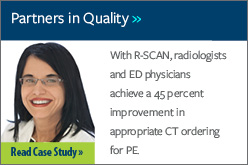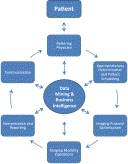Giles W. Boland, MD, Richard Duszak Jr., MD, Geraldine McGinty, MD, MBA, Bibb Allen Jr., MD
Editor’s note: The following article first appeared in the JACR: “Delivery of Appropriateness, Quality, Safety, Efficiency and Patient Satisfaction,” Boland, Giles W. et al. Journal of the American College of Radiology, volume 11, issue 3, 225–226. Additional content is provided here with the goal of connecting the concepts with ACR tools and resources.
Although radiology’s dramatic evolution over the last century has profoundly affected patient care for the better, the current system is too fragmented and many providers focus more on technology and physician needs rather than what really matters to patients: better value and outcomes. This latter dynamic is aligned with current national health care reform initiatives and creates both challenges and opportunities for radiologists to find ways to deliver new value for patients. The ACR has responded to this challenge with the introduction of Imaging 3.0™, which represents a call to action to all radiologists to assume leadership roles in shaping America’s future health care system through 5 key pillars: imaging appropriateness, quality, safety, efficiency, and satisfaction. That enhanced value will require modulation of imaging work processes best understood through the concept of the imaging value chain, which is introduced in this first of a 7-part series . Further articles will then prescribe in detail the pathway forward at each link in the value chain to effect the work process changes necessary for radiologists to deliver better value and outcomes for patients.
The Imaging 3.0 Call to Action
 Under Imaging 1.0, the era of analog imaging, radiologists steadily gained increasing importance in the role of the delivery of health care. This role has been dramatically amplified over the last generation with the ongoing development and deployment of the digital imaging revolution during the Imaging 2.0 era. This spawned the development of subspecialty radiology and further raised the overall profile of the profession; radiologists are now critical to the investigation of most diseases. Yet the digital nature of Imaging 2.0 has led to unintended consequences. Clinical interactivity with both referring physicians and patients has diminished dramatically, and the delivery of imaging services has become increasingly fragmented, primarily through teleradiology, such that some are now even questioning the value and future role of radiologists. As a response, the ACR has introduced the Imaging 3.0 initiative [1, 2].
Under Imaging 1.0, the era of analog imaging, radiologists steadily gained increasing importance in the role of the delivery of health care. This role has been dramatically amplified over the last generation with the ongoing development and deployment of the digital imaging revolution during the Imaging 2.0 era. This spawned the development of subspecialty radiology and further raised the overall profile of the profession; radiologists are now critical to the investigation of most diseases. Yet the digital nature of Imaging 2.0 has led to unintended consequences. Clinical interactivity with both referring physicians and patients has diminished dramatically, and the delivery of imaging services has become increasingly fragmented, primarily through teleradiology, such that some are now even questioning the value and future role of radiologists. As a response, the ACR has introduced the Imaging 3.0 initiative [1, 2].
Imaging 3.0 is a call to action to all radiologists to assume a leadership role in shaping America’s future health care system [1, 2]. The campaign’s goal is for radiologists to move beyond being simply image interpreters to become integrated leaders in the new and evolving health care environment. Imaging 3.0’s thrust is for radiologists to deliver enhanced value to patients through 5 key pillars: imaging appropriateness, quality, safety, efficiency, and satisfaction [1, 2]. For this effort to succeed, radiologists must be primary drivers (rather than followers) of the change processes necessary to achieve the vision of Imaging 3.0.
Culturally and professionally indoctrinated into focusing on procedural volume, radiologists will need instead to prioritize value (the so-called volume to value dynamic), a measure unfamiliar to most radiologists [3, 4, 5]. Imaging 3.0 is not so much a repudiation of Imaging 1.0 and 2.0, but rather the next step in the evolution of medical imaging. It offers the major benefits of these 2 eras, but primarily focuses on the advancement of 2 key concepts: information integration and patient centricity. Put together, these place patients at the center of the imaging work process, which will be transformed into one dedicated to delivering enhanced patient value.
This article represents the first in a series of 7 designed to guide radiologists through the important and necessary Imaging 3.0 transformation process. Herein, we discuss the general concept of the imaging value chain and outline the scope of the tasks at hand.
Value Is Our Future
For radiologists, future success will require a change in mindset to embrace the full scope of the Imaging 3.0 vision. This can be crystallized into a single and simple question: How can we deliver more value to patients? Getting there will require a fundamental rethink of the radiologists’ work product. Indeed, few health care organizations in the United States have substantially changed their culture to adapt to the changes afoot in health care. Some are beginning to explore ways to deliver better value to patients, but most are perplexed as how best to proceed. Many of the answers lie in adopting and following best practices. But health care as an industry has a problem of execution. Even though a number of best practice guidelines have been developed and despite abundant data, the workflows and practices of many, if not most, health care organizations vary substantially. Profound variation is inherent to medical practice, and imaging is no exception [6, 7, 8, 9, 10, 11]. It is almost certain that no 2 imaging departments in the nation use the same imaging appropriateness criteria, modality protocols, and workflows; the same interpretation tools, recommendation guidelines, reporting, and communication criteria. Standardization and the adoption of evidence-based care in medical practice fundamentally competes with the cultural axiom that a physician always “knows what’s best” for his or her patients and this will be one of the biggest obstacles of creating and implementing a robust blueprint for Imaging 3.0.
Fortunately, although practice variation abounds, solutions are not as daunting as they might first appear. The radiology work process is inherently digital, which offers radiologists unique opportunities to leverage information technology (IT) to meet the expectations of Imaging 3.0. Yet, only few departments nationwide, if any, have fully leveraged IT, as well as their workforce and work processes, to comprehensively address the full range and scope of Imaging 3.0. Furthermore, Imaging 3.0 is designed to be a dynamic process. As practices and technology evolve, perpetual modifications will be necessary to deliver ever better value to patients. The question is, how do we get there? How do radiologists change their work processes to deliver better value to patients?
 The answers to these questions can be found by turning to the business community. The knowledge, tactics, and tools needed to answer the value question have been well known to the business community for decades. Successful businesses live and die by their ability to deliver ever better value to their customers. Although there are numerous methodologies that businesses employ to stay competitive, the “value-chain” concept has pervaded the business landscape for nearly 30 years and is now embedded into many successful business workflow practices [12, 13]. It is through optimization of the value-chain work processes that businesses deliver enhanced customer value. As it happens, this is also the ultimate goal of Imaging 3.0. This series of articles will, therefore, use the concept of the imaging value chain to outline key imaging work processes necessary for delivering a radiology department’s ultimate value: timely and actionable information. This first article introduces steps and general concepts of the imaging value chain and outlines the scope of the task at hand. Separate subsequent articles will evaluate each link in the chain in detail and will provide solutions for workflow optimization that in aggregate deliver this enhanced value.
The answers to these questions can be found by turning to the business community. The knowledge, tactics, and tools needed to answer the value question have been well known to the business community for decades. Successful businesses live and die by their ability to deliver ever better value to their customers. Although there are numerous methodologies that businesses employ to stay competitive, the “value-chain” concept has pervaded the business landscape for nearly 30 years and is now embedded into many successful business workflow practices [12, 13]. It is through optimization of the value-chain work processes that businesses deliver enhanced customer value. As it happens, this is also the ultimate goal of Imaging 3.0. This series of articles will, therefore, use the concept of the imaging value chain to outline key imaging work processes necessary for delivering a radiology department’s ultimate value: timely and actionable information. This first article introduces steps and general concepts of the imaging value chain and outlines the scope of the task at hand. Separate subsequent articles will evaluate each link in the chain in detail and will provide solutions for workflow optimization that in aggregate deliver this enhanced value.
The Chain from Volume to Value
In his book, “Competitive Advantage: Creating and Sustaining Superior Performance,” Michael Porter introduced the concept of the value chain as a “systematic way of examining all the activities a firm performs and how they interact (which) is necessary for analyzing the sources of competitive advantage” [12]. Each link of that chain represents a discrete number of unique value opportunity activities, such as design, production, marketing, delivery, and support. Their aggregate is what a customer purchases and experiences. Put another way, “value activities are the discrete building blocks of competitive advantage” [12, 13].
Given the current health care focus on delivering better value to patients (simplistically defined as outcomes divided by cost) health care organizations are increasingly turning to the concept of the value chain [3, 4]. The term has even started to percolate into the radiology parlance [5]. Ironically, much of the macro thinking behind health care reform has also come from Michael Porter, who has argued for years that health care must shift away from its current system, which focuses on value to providers, to a dramatically new one, which prioritizes value to their customers (ie, their patients) [3, 4, 5, 6]. Porter argues that providers—both hospitals and physicians—have had goals that conflict to the one of delivering better value to patients [4]. Although providers may desire the best treatments and outcomes for their patients, they frequently define success based on revenue-generating activities (usually the number of procedures performed). Given these misaligned incentives, it is not surprising that the costs of US health care are about twice that of many other industrialized nations [14].
The new health care dynamic, embodied in the controversial Affordable Care Act, attempts to gear the delivery of health care away from a volume-based paradigm to one that is value-based—one where value is defined by the patient rather than the provider [3, 4, 15, 16, 17]. CMS plans to implement 65 measures in 5 domains as the basis for future payments [18, 19]. Most will address quality, patient safety, and experience—all key pillars of Imaging 3.0—and so, notwithstanding the patient care impact of these goals, radiologists will increasingly be incentivized to pursue Imaging 3.0 initiatives. Future compensation will take the form of global or capitated payments based on the populations served by a provider or those tightly linked to an “episode” of care that encompasses a standard complete care continuum (often from presentation to recovery) [3, 4, 20, 21].
 Accordingly , future payments will be aligned with results, rather than with volumes, shifting the focus from outputs to outcomes [3, 4]. Whether new payment models will truly result in better patient outcomes remains uncertain, but the metaphorical “train has left the station.” No longer can physicians assume that more procedures will mean more money. Many questions remain as to how providers will divide limited bundled payments for given episodes of care, but physicians, including radiologists, will need to collaborate and coordinate their disparate activities far more closely to achieve better outcomes for patients—and payments for themselves [20]. The shift from volume to value will therefore require all providers to re-engineer their work processes. To achieve success in new delivery models, radiologists will need to reorganize their activities to achieve these goals. Fortuitously, and by design, these are in tandem with the goals of Imaging 3.0.
Accordingly , future payments will be aligned with results, rather than with volumes, shifting the focus from outputs to outcomes [3, 4]. Whether new payment models will truly result in better patient outcomes remains uncertain, but the metaphorical “train has left the station.” No longer can physicians assume that more procedures will mean more money. Many questions remain as to how providers will divide limited bundled payments for given episodes of care, but physicians, including radiologists, will need to collaborate and coordinate their disparate activities far more closely to achieve better outcomes for patients—and payments for themselves [20]. The shift from volume to value will therefore require all providers to re-engineer their work processes. To achieve success in new delivery models, radiologists will need to reorganize their activities to achieve these goals. Fortuitously, and by design, these are in tandem with the goals of Imaging 3.0.
The steps below represent discrete integrated components of the imaging value chain. These are briefly introduced and outlined below in this first of a 7-part series, which lays the foundation for forthcoming detailed articles focusing on each step. A schematic representation of Imaging 3.0 outlines the backbone of the imaging value chain (Fig. 1).

Fig. 1: Schematic representation of the imaging value chain.
View Large Image | View Hi-Res Image | Download PowerPoint Slide
Imaging appropriateness and patient scheduling
The value chain begins when a patient presents to their physician with a medical complaint or for a routine visit. If imaging is indicated, that physician must first be aware of what imaging tests are available and, perhaps more importantly, when they are appropriate. Additionally, ordering physicians must be cognizant of radiation safety issues for their patients and the need to avoid unnecessary duplicate testing. This represents the first pillar of Imaging 3.0 and the first link in the imaging value chain (Fig. 1). Unfortunately, most organizations do not have consistent and reproducible work processes that ensure imaging appropriateness. Accordingly, marked variation in practice, therefore, exists across the nation, undermining radiologists’ and departments’ ability to deliver maximal patient value [7, 8, 9, 10, 11]. Ultimately, it will be through the use electronic decision support tools with embedded information regarding radiation safety, combined with peer-to-peer consultations with radiologists, that referring physicians will be able to request the appropriate imaging test at the point of care for the right patient at the right time, in a timely and seamless manner [22]. Such referring physician imaging appropriateness and scheduling value activities will be detailed in part 2 of this series.
Imaging protocols
After the appropriate imaging modality has been selected, the radiologist must determine the optimal imaging protocol for that particular patient given the clinical situation. Optimal protocol choice will vary dependent on indication, ancillary clinical information, age, weight, previous imaging, modality access and availability, staffing resources, patient preferences, amongst others. Once again, marked variation is present across the nation, again limiting a department’s value and patient outcomes [7, 8, 9, 10, 11]. Much data, however, exist on managing these variables, and part 3 in this series will detail mechanisms to effectively implement consensus based best practices.
Modality operations
A key patient safety, efficiency, and patient satisfaction metric (the third, fourth and fifth Imaging 3.0 pillars) is the efficiency of the modality operations, particularly as it pertains to patient access and experience. Again, variation in operational performance is widespread in the industry [23, 24, 25]. Many organizations operate in a relatively customer unfriendly environment and many hospital-based modality operations do not tailor their workflows sufficiently to cater for the inherent differences between inpatient versus outpatient scanning. Additionally, many organizations with multiple imaging sites and modalities coordinate their activities too poorly to maximize patient access and throughput across their network. Part 4 in this series will detail mechanisms to optimize patient experience and modality operations in conjunction with ACR accreditation standards.
Image interpretation and reporting
The ultimate goal of a radiology department is to deliver timely, meaningful, and actionable information [5]. Evidence-based actionable reporting requires that radiologists extract, either alone or through the use of computer-aided tools, all available meaningful image data and then synthesize these findings with collateral clinical information into a precise, crystallized, organized reports. Additionally, integration of specialty society guidelines for recommendations will lead to standardization of recommendations through clinical decision-support systems for radiologists and enhance the ability to provide critical results reporting and recommendation tracking. This increasingly requires real-time integration of image and other relevant electronic medical data [26]. Given the variable availability, functionality, and integration of institutional IT environments, the precision of actionable reporting will vary from one institution to another. Part 5 in this series will detail the radiologist reporting process and recommend modifications to this value activity to optimize actionable reporting.
Report communication and referring physician interaction
An actionable report is meaningless until it is widely and readily accessible to appropriate caregivers. Departments have different methodologies and protocols for report communication and opportunities exist to ensure that actionable information reaches appropriate referrers in a timely manner consistent with the acuity of the findings and clinical scenario. Part 6 in this series will address methods of report communication and demonstrate how refinements to communication algorithms can enhance the quality and safety of clinical care and, therefore, the patient and referring physician experience.
Data mining, business intelligence and future trends
The routine use of relevant emerging business intelligence tools will be critical to the effective monitoring of all components of the imaging value chain ranging from adherence to imaging appropriateness guidelines, to modality capacity, patient throughput and experience, radiation dose exposure, report ontology and standardization, and communication standards, amongst many others [5]. Timely analysis and appropriate modification and iteration of the radiology value chain will be required to assure radiologists continue to contribute to improved patient outcomes. The seventh and final part in this series will discuss key performance indicators required to monitor the imaging value chain and will discuss how to use these data to deliver the 5 pillars of Imaging 3.0. Additionally, it will explore the emerging use of “big data” to identify phenotypic imaging similarities identified between populations so as to define subpopulations of patients with similar findings that might have implications for diagnosis, therapy and outcomes, one of the key goals of delivering precision medicine [27].
Take-Home Points
- Imaging 3.0 represents a call to action to all radiologists to assume leadership roles in shaping America’s future health care system.
- As evolving health care delivery models increasingly change their focus from providers to patients and from volume to value, radiology practices that align their priorities accordingly will more likely achieve success than those which do not.
- The imaging value chain highlights opportunities at each step in the delivery of radiology services for radiologists to best deliver value to their patients.
Value Chain Series
- Delivery of Appropriateness, Quality, Safety, Efficiency and Patient Satisfaction
- Appropriateness, Scheduling, and Patient Preparation
- Protocol Design and Optimization
- Optimizing Modality Operations
- Actionable Reporting
- Communication of Actionable Information
- Business Intelligence, Data Mining, and Future Trends
References
- ACR, Imaging 3.0. Available at:http://www.acr.org/Advocacy/Economics-Health-Policy/Imaging-3. Accessed June 8, 2013.
- Imaging 3.0. Available at: http://www.acr.org/∼/media/ACR/Documents/PDF/Economics/Imaging 3/Imaging3.pdf. Accessed June 8, 2013.
- Porter, M.E. What is value in health care?. N Engl J Med. 2010; 363: 2477–2481
- Porter, M.E. A strategy for health care reform – towards a value-based system. N Engl J Med. 2009; 36: 109–112
- Enzmann, D.R. Radiology’s value chain. Radiology. 2012; 263: 243–252
- Lee, C.I. and Enzmann, D.R. Measuring radiology’s value in time saved. J Am Coll Radiol. 2012; 9: 713–717
- Onega et al. Geographic and Sociodemographic Disparities in PET use by Medicare beneficiaries with cancer. J Am Coll Radiol. 2012; 9: 635–643
- Levin, D.C., Rao, V.M., Parker, L., and Frangios, A.J. Medicare Payments for Noninvasive Diagnostic Imaging Are Now Higher to Nonradiologist Physicians Than to Radiologists. J Am Coll Radiol. 2011; 8: 26–32
- Parker, L., Levin, D.C., Frangios, A., and Rao, V.M. Geographic variation in the utilization of non-invasive diagnostic imaging: national Medicare data, 1998-2007. Am J Roentgenol. 2010; 194: 1034–1039
- Boland, G.W.L. From herding cats towards best practices: standardizing the radiology work process. Am J Roentgenol. 2009; 193: 1593–1595
- The $2.7 Trillion Medical Bill. Available at: http://www.nytimes.com/2013/06/02/health/colonoscopies-explain-why-us-leads-the-world-in-health-expenditures.html?pagewanted=all&_r=0. Accessed June 8, 2013.
- Porter ME. Competitive Advantage: Creating and Sustaining Superior, New York: Performance Free Press.
- Value Chain. Available at: http://www.economist.com/node/14301710. Accessed June 8, 2013.
- A More Secure Future: What the New Health Law Means for You and Your Family. Available at: http://www.whitehouse.gov/healthreform. Accessed June 8, 2013.
- Compilation of the Patient Protection and Affordable Care Act. Available at: http://housedocs.house.gov/energycommerce/ppacacon.pdf. Accessed June 8, 2013.
- Affordable Care Act. Available at: http://www.cms.gov/Regulations-and-Guidance/HIPAA-Administrative-Simplification/Affordable-Care-Act/index.html?redirect=/Affordable-Care-Act/. Accessed June 8, 2013.
- CMS: Accountable Care Organization 2013: Program Analysis. Available at: http://www.cms.gov/Medicare/Medicare-Fee-for-Service-Payment/sharedsavingsprogram/Downloads/ACO-NarrativeMeasures-Specs.pdf. Accessed June 8, 2013.
- Berwick, D.M. Launching accountable care organizations – the final rule for Medicare Shared Savings Program. N Eng J Med. 2011; 365: 1753–1756
- Breslau, J. A radiologist’s perspective primer on accountable care organization. J Am Coll Radiol. 2011; 8: 164–168
- Landon, B.E. Keeping score under a global payment system. N Engl J Med. 2012; 366: 393–395
- Sistrom, C.L. et al. Effect of computerized order entry with integrated decision support on the growth of outpatient procedure volumes: seven-year time series analysis. Radiology. 2009; 251: 147–155
- Boland, G.W.L., Houghton, M.P., Marchione, D.G., and McCormick, W. Maximizing outpatient computed tomography productivity using multiple technologists. (199-25)J Am Coll Radiol. 2008; 5
- Enzman, D.R. and Schomer, D.F. Analysis of radiology business models. J Am Coll Radiol. 2013; 10: 175–180
- The Radiation Boom: After Stroke Scans, Patients Face Serious Health Risk. Available at: http://www.nytimes.com/2010/08/01/health/01radiation.html?scp=1&sq=overdose radiation&st=cse. Accessed June 8, 2013.
- Silva E, et al. ACR White Paper on Teleradiology Practice: A Report From the Task Force on Teleradiology Practice. J Am Coll Radiol 2013 (in Press) Available at: http://download.journals.elsevierhealth.com/pdfs/journals/1546-1440/PIIS1546144013001853.pdf. Accessed June 8, 2013
- Thrall, J.H. Data mining, knowledge creation, and work process enhancement in the second generation of radiology’s digital age. J Am Coll Radiol. 2013; 3: 161–163